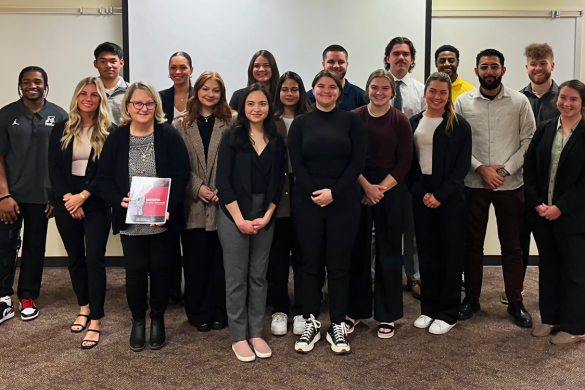
Brody Deno (left) and Scott Custer (right) explain how farmers harvest the blue agave plant used to make tequila. Farming was one of the stations at the Experience Design 101 class’ Tequila to You event on Nov. 30. Photo by Reid Lorey
Students who attended the Tequila to You event on Nov. 30 had the opportunity to act as new employees for the fictional company of Viva Tequila. Participants were taken step by step through the supply chain of tequila, with different stations set up throughout UIndy Hall.
The Supply Chain Club sponsored the event, and students in the Experience Design 101 class worked throughout the semester to plan the event. Students at the event were taken through the necessary steps to bring tequila to the shelves for consumers in the United States.
According to supplychaingang.com, the history of tequila dates back before the Spanish conquest of “the New World” began. Tequila comes from the blue agave plant, primarily grown in the area of Tequila, a rural town near Jalisco, Mexico.
Supplychaingang.com talks about the indigenous people of Jalisco, using the plant to make rope, thread, needles, roofing materials, detergent and even soap. It was later distilled and used for drinking, before eventually becoming North America’s first distilled drink and commercially produced alcohol.
Senior computer science major Jacolby Hartson worked on the marketing side of the event. He worked to promote the event on campus by sending out emails, talking with professors to give students extra credit who attend and getting permission to allow students the opportunity to receive L/P credit by filling out a facts sheet throughout the event.
Hartson also helped with research to better understand the different intermediaries tequila passes through before arriving on the shelves.
“It was crazy to see how they distill it [tequila],” Hartson said. “It’s really impressive how concise everything has to be and all of the steps it has to go through… You don’t really think of all the steps it takes for tequila to make it on the shelves when going to the store and buying it.”
When arriving at the event in UIndy Hall, attendees were separated into small groups and were escorted through the supply chain. The first stop was farming, where a large picture of a blue agave plant was projected, the group discussed some of the backbreaking work farmers go through when harvesting this plant.
Next was taking the plant to distillation. Here, the plant is first baked and crushed, and later yeast and water are added to the plant juices. The product is then aged before being bottled.
After bottling, participants were then taken through the strict process of transporting it across the border, into the United States. Lastly, the product goes to shipping and is sent to final retail.
After being taken through the supply chain line of tequila, participants were able to sit at a bar and enjoy non-alcoholic drinks.
Junior Exercise Science major Dillon Hurst discussed the distillation process. Before being able to present the development of tequila from the blue agave plant, he had to research all of the precise processes must be followed when making tequila.
“I was really surprised at the size of the agave plant,” Hurst said. “I had no idea that it had to be baked before extracting the juices and there can be hundreds of agave plants baking in the same oven at one time…It’s surprising how extensive the supply chain of tequila is and how careful you have to be when choosing a topic to cover due to some legal restrictions on specific products. I really liked doing the research for this event and learning all of the stages the blue agave plant goes through to become tequila.”
ust be followed when making tequila.
“I was really surprised at the size of the agave plant,” Hurst said. “I had no idea that it had to be baked before extracting the juices and there can be hundreds of agave plants baking in the same oven at one time…It’s surprising how extensive the supply chain of tequila is and how careful you have to be when choosing a topic to cover due to some legal restrictions on specific products. I really liked doing the research for this event and learning all of the stages the blue agave plant goes through to become tequ






